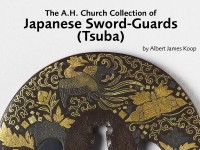The A. H. Church Collection of Japanese Sword-Guards (Tsuba)
An unpublished catalogue of the A. H. Church collection of Japanese sword-guards (tsuba) by Albert James Koop.

The founder, Akao Yoshitsugu I, [Japanese text], born towards 1700 at Fukui in Echizen, was a samurai in the service of the Matsudaira, lords of that province. His son, Yoshitsugu II, moved the school to Yedo, leaving a branch behind in Echizen. Pierced and modelled designs showing Kawaji and Kinai influence are characteristic of this provincial branch, but the Yedo school pursued a development of the Akasaka style, in which positive silhouettes of natural or artificial objects are reduced to forms so conventionalised as sometimes to defy identification.
 Tsuba with three fans (EAX.10732)
Tsuba with three fans (EAX.10732)
 Tsuba with himono, or dried salmon (EAX.10733)
Tsuba with himono, or dried salmon (EAX.10733)
 Tsuba with five sails (EAX.10734)
Tsuba with five sails (EAX.10734)
 Lenticular tsuba with a fan and Chinese crown (EAX.10735)
Lenticular tsuba with a fan and Chinese crown (EAX.10735)
 Tsuba with gosan-no-kiri, or paulownia leaves (EAX.10761)
Tsuba with gosan-no-kiri, or paulownia leaves (EAX.10761)
 Tsuba with five dragonflies (EAX.10762)
Tsuba with five dragonflies (EAX.10762)
Notice
Object information may not accurately reflect the actual contents of the original publication, since our online objects contain current information held in our collections database. Click on 'buy this publication' to purchase printed versions of our online publications, where available, or contact the Jameel Study Centre to arrange access to books on our collections that are now out of print.
© 2013 University of Oxford - Ashmolean Museum




